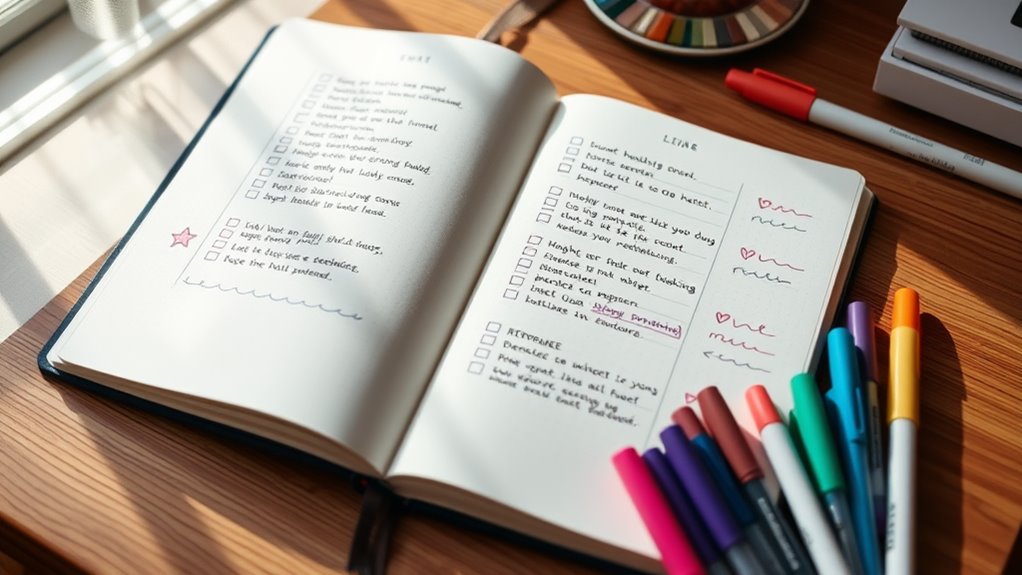Bullet Journaling Tips for People Who Can’t Draw
You don’t need artistic skills to enjoy bullet journaling. Start by embracing minimalism—stick to simple layouts and clean lines. A dotted or grid notebook works best, along with smooth-flowing pens. Use stickers and washi tape to add fun without drawing. For your layouts, try monthly spreads in a grid format and use basic bullet points to keep tasks organized. Tracking habits or moods can be easy with simple grids or lists. You can personalize your journal with themes and inspirational quotes. Keep going, and you’ll discover even more tips and tricks to enhance your journaling experience.
Key Takeaways
- Embrace minimalism by using simple layouts with clean lines and a limited color palette for a cohesive look.
- Utilize basic tools like dotted notebooks and smooth-flowing pens to enhance your bullet journaling experience without needing artistic skills.
- Incorporate stickers and washi tape for decoration, adding a personal touch without requiring drawing abilities.
- Focus on straightforward tracking techniques, such as grids for habit trackers and lists for meal planning, to stay organized.
- Handwrite inspirational quotes or affirmations to personalize your journal while keeping designs uncomplicated.
Embrace Minimalism
When you embrace minimalism in your bullet journal, you’ll find that less truly is more. By stripping away unnecessary elements, you create a space that fosters clarity and focus.
Start with simple layouts, using clean lines and ample white space. Instead of cluttering your pages with elaborate designs, prioritize essential information and only include what matters most to you.
Use a limited color palette to maintain a cohesive look and feel throughout your journal. This approach not only simplifies your planning but also makes it more enjoyable.
You’ll discover that minimalism encourages mindfulness, helping you stay grounded in your goals and intentions. So, take a deep breath and let go of the excess—your bullet journal journey is about quality, not quantity.
Essential Tools for Beginners
Getting started with bullet journaling doesn’t require a lot of fancy materials—just a few essential tools will do.
Here’s what you’ll need to kick things off:
- Notebook: Choose a dotted or grid notebook that feels good to write in.
- Pen: Pick a pen that flows smoothly; gel pens or fineliners are popular choices.
- Ruler: A ruler helps you create clean lines and organize your layouts.
- Stickers or Washi Tape: These add a fun touch without needing artistic skills.
With these basics, you’re ready to explore your creativity and customize your bullet journal to fit your needs.
Simple Layout Ideas
A simple layout can make your bullet journal both functional and visually appealing. Start with a basic monthly spread, using a grid format to organize days and tasks. You can easily highlight important events or deadlines with colored markers or stickers.
For weekly spreads, try a vertical or horizontal layout to keep your tasks clear and manageable. Use simple headers and bullet points to categorize your entries, like work, personal, or goals.
If you prefer a minimalist approach, stick to black and white, focusing on clean lines and ample white space. You don’t need intricate designs; just guarantee your layout supports your planning needs.
Easy Tracking Techniques
To enhance your bullet journaling experience, incorporating easy tracking techniques can make a significant difference in staying organized.
You don’t need fancy drawings to make your journal effective. Here are some simple tracking ideas you can easily implement:
-
Habit Tracker: Use a grid to mark daily habits you want to build.
-
Mood Log: Create a color-coded system to reflect your mood each day.
-
Water Intake Tracker: Draw a simple line or bar to track how much water you drink.
-
Meal Planner: Outline your meals for the week in a straightforward list format.
These techniques not only streamline your process but also help you visualize your progress without needing artistic skills.
Happy journaling!
Personalization Without Drawing
While many people associate bullet journaling with intricate drawings and elaborate designs, you can still personalize your journal in meaningful ways without needing artistic talent.
Start by choosing a theme or color scheme that resonates with you. Use stickers, washi tape, or colored pens to add flair without requiring drawing skills.
Experiment with different layouts for your monthly or daily logs—try grids, lists, or simple icons to keep it visually appealing. Incorporate quotes or affirmations that inspire you, using your own handwriting for a personal touch.
Don’t forget to include sections for your goals, habits, or reflections; these elements make your journal uniquely yours.
Ultimately, your bullet journal should reflect your personality and help you stay organized, no artistry required!
Frequently Asked Questions
Can I Use a Digital Bullet Journal Instead of Paper?
Absolutely, you can use a digital bullet journal instead of paper. It’s flexible and often includes features like templates and reminders, making it easier for you to stay organized and inspired without the hassle of traditional journaling.
How Much Time Should I Spend on My Bullet Journal Daily?
You should spend about 10 to 30 minutes daily on your bullet journal. This way, you can stay organized and reflect on your goals without feeling overwhelmed. Find a routine that fits your lifestyle best.
What if I Miss a Day in My Bullet Journal?
If you miss a day in your bullet journal, don’t stress. Just pick up where you left off. You can always fill in missed entries later or simply move forward with your current plans.
Can I Incorporate Stickers Into My Bullet Journal?
Absolutely, you can incorporate stickers into your bullet journal! They add personality and flair, making your pages more visually appealing. Just choose designs that resonate with you and enhance your overall theme and organization.
Is It Necessary to Follow a Specific Bullet Journal Method?
It isn’t necessary to follow a specific bullet journal method. You can create your own system that suits your needs. Experiment with different layouts and find what works best for you; make it uniquely yours!



